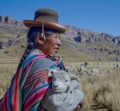ANDES
First it was a frog. Then, catfish. Now, researchers on a major expedition in Bolivia’s Madidi National Park have announced more new species that were, until now, unknown to science. In total, the expedition has uncovered three new frogs, three catfish, and a lizard species.
...
A new report launched today by the United Nations Environment Programme (UNEP), GRID-Arendal and the Consortium for Sustainable Development of the Andean Ecoregion (CONDESAN) recommends that adapting to climate change in the tropical Andes requires a regional strategy that must...
The Gordon and Betty Moore Foundation — the biggest private supporter of conservation in the world’s largest rainforest — has pledged another $100 million toward efforts to establish and support protected areas across the Andes-Amazon landscape.
The five-year commitment,...
Glaciers made an unusual appearance on a primetime American television network last month: the television series Madam Secretary aired an episode...
Glaciers made an unusual appearance on a primetime American television network last month: the television series Madam Secretary aired an episode...
It’s shiny, blue-green, oval-shaped and has a fondness for human excrement, among other less-than-appetizing meals. But it’s about to be something of a star in the entomology world.
El turismo de naturaleza se viene posicionando en todas las regiones del país. El Gobierno Regional de La Libertad declaró como principal destino turístico local al Santuario y Reserva Nacional de Calipuy, áreas protegidas administradas por el Servicio Nacional de Áreas Naturales...
Two recent studies offer complementary accounts of the ways that glacier retreat and other impacts of climate change have displaced indigenous people from their communities in the Peruvian Andes. One describes the people who have left as refugees, the other as migrants. Both emphasize...
As stated in a recent Fun Fact Friday article about potatoes, the tasty tubers might be grown all over the world today, but they originated in Peru between 7,000 and 10,000 years ago....
The Andes mountain range defines the topography of the South American countries of Bolivia, Chile, Colombia, Ecuador, and Peru and provides vital ecosystem services to the region. These mountains host more than 99% of the world’s tropical glaciers and are essential in supplying water...









